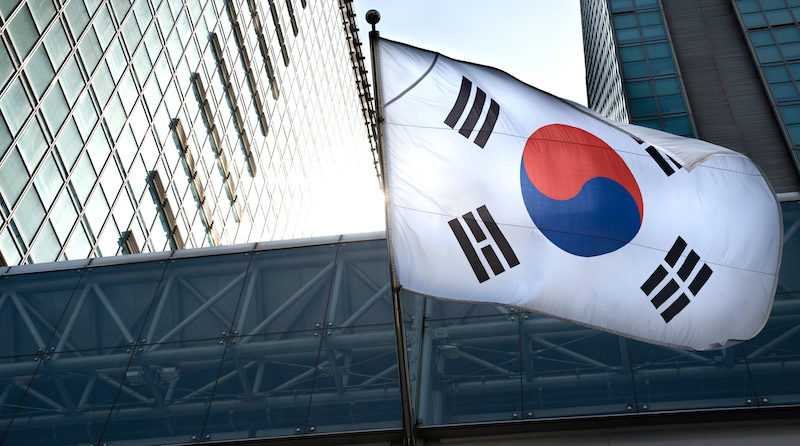
Transparency, communication, and collaboration are the key weapons in the fight against COVID-19.
South Korea and the United States both confirmed their first COVID-19 cases on January 20. Since then, the two countries have taken drastically different actions to address the pandemic.
Korea’s very effective model has been based on a “TRUST” strategy—an acronym for “Transparency, Robust screening and quarantine, Unique but universally applicable testing, Strict control, and Treatment.” South Korea’s ability to test, trace, and treat infected people has allowed the nation’s leaders in Seoul to control the spread of the virus without imposing the aggressive lockdowns or complete travel bans that other countries have adopted.
South Korea’s strong response to COVID-19 can serve as a lesson for the rest of the world. But South Korean health officials learned this lesson the hard way several years ago.
The TRUST campaign and other South Korean efforts to combat COVID-19 emerged following the traumatic experience of the 2015 outbreak of Middle East Respiratory Syndrome (MERS), an illness that was also caused by a coronavirus. South Korea suffered the largest MERS outbreak outside of the Middle East—there were over 180 reported cases, almost 40 deaths, and nearly 17,000 people placed under quarantine. Korea’s current President Moon Jae-in, who was the opposition party leader during the MERS outbreak, criticized government authorities as “super spreaders of MERS” for their slow-footed response.
What kind of institutional and legal changes did South Korea adopt to transform itself from a “super spreader” of MERS to a “super stopper” of COVID-19?
Just as with any other crisis, pandemic response requires centralized leadership and a clear chain of command. In its early stages, the MERS outbreak caught Korean authorities off-guard. At that time, Korea’s legal framework for disease prevention, the Infectious Disease Control and Prevention Act, had not been updated to include MERS on its list of infectious diseases, and therefore, the government lacked a legal basis for a more extensive response. Furthermore, Korea failed to adopt the World Health Organization’s MERS recommendations issued in 2014, which suggested that countries increase MERS awareness and incorporate MERS prevention and response measures into existing legal frameworks.
In the face of the 2015 outbreak, Korean authorities established several new organizations and ended up creating five competing and overlapping chains of command—without issuing clear guidelines for interagency collaboration. The Korea Center for Disease Control and Prevention (KCDC), under the Ministry of Health and Welfare, led the response to MERS, but it lacked independent decision-making power and a channel for horizontal collaboration with other ministries. The Ministry of Health also formed the Central MERS Management Headquarters, while the former Ministry of Public Safety and Security—which has since merged with the Ministry of the Interior—created the MERS Response Support Headquarters. As a result, the KCDC spent more time explaining situations to bureaucrats than actually using its resources to confront MERS.
Furthermore, during the MERS outbreak the government never assembled its Central Disaster and Safety Countermeasure Headquarters, which would have reported directly to the Prime Minister and would have overseen all of the ad hoc headquarters. Assembling the Central Disaster and Safety Countermeasure Headquarters would have required the government to raise the national alert level from caution (yellow) to warning (orange), something it never did during the MERS outbreak.
Since the MERS outbreak, the KCDC gained greater authority as Korea’s primary epidemic control center, with its director receiving an upgrade to the level of deputy minister. When COVID-19 struck in January 2020, Korea’s political leaders took a back seat to the scientific experts at the center, which helped establish public trust for various draconian social distancing and quarantine measures. The current KCDC Director, Jung Eun-kyeong, leads the country’s daily briefing, and the KCDC has an approval rating of more than 70 percent. Foreign media laud her as a national hero for her leadership and clear communication.
South Korea also learned its lesson about raising its national alert level more quickly with COVID-19 than it had with MERS. The Korean government raised the alert to yellow with the first confirmed case on January 20, to orange on January 27 with four confirmed cases, and finally to red, the highest alert level, on February 23. With the country on red alert, the Central Disaster and Safety Countermeasure Headquarters was activated to coordinate response efforts, with the Prime Minister as its top commander.
Another major lesson from South Korea’s response to COVID-19 is the importance of early and extensive testing, accurate diagnoses, and the establishment of close partnerships between government and private companies to support best the crisis response.
In 2015, Korea’s public health system missed a golden opportunity for detecting the outbreak because a newly developed MERS in-vitro diagnostic kit had not passed clinical trials and could not be used outside of the KCDC. The lack of testing prompted people infected with MERS to visit multiple hospitals, turning those hospitals into the country’s main sites of disease transmission.
After the MERS outbreak, South Korea enacted an amendment to the Medical Devices Act that promoted public-private medical partnerships and established an emergency use authorization policy. This law now permits the government to authorize the use of unapproved in-vitro diagnostic test kits in an emergency when no approved diagnostic tests are available.
Within one week of the first confirmed COVID-19 case, representatives from the Korean Society for Laboratory Medicine, the KCDC’s Center for Infectious Diseases Research, and biotech companies convened to stress the urgency of developing a COVID-19 test kit. The first authorization of an unlicensed COVID-19 test came in early February, with three more test methods approved by the end of February. As a result, national and private health care providers set up a mostly free testing effort across Korea that includes more than 600 locations that screen up to 20,000 people a day. Korean national authorities also welcomed innovative experiments by local governments and hospitals such as drive-through and walk-through test stations. The government provided ex post approval and guidelines for these testing facilities, and these guidelines about drive-through and walk-through testing facilities quickly circulated around the world.
South Korea’s response has also demonstrated the importance of crisis communication—providing credible information and preventing the spread of misinformation.
During the MERS outbreak, Korean authorities withheld key information about patients’ locations due to concerns that the public would panic and demand that hospitals treating MERS patients shut down completely. This lack of transparency undermined the government’s credibility and ultimately harmed efforts to prevent the spread of MERS.
The public began seeking and sharing information about MERS through alternative communication channels. For example, a citizen-made MERS map—a website where people could identify hospitals and other locations where MERS had been reported—circulated widely.
Fake news also spread like wildfire. This breakdown in communication led to greater fears among the public and compromised public health directives. The lack of communication from national authorities also led to conflicts with local governments, some of whom decided to contradict KCDC guidelines and release information about confirmed MERS cases in their localities based on the public’s “right to know.”
In the aftermath of MERS, the KCDC established the Office of Risk Communication to provide guidance about how to disclose trustworthy information promptly and provide consistent guidelines preemptively. South Korean officials also revised the Infectious Disease Control and Prevention Act to grant public health officials’ greater authority to shut down facilities and gain access to personal information of people likely to be infected. Korean public health authorities and local governments may now collaborate to obtain information about infected peoples’ movements during a public health emergency—using closed circuit television footage, cell phone records, credit card receipts, and other private data.
Requiring disclosures of personal information helps prevent unnecessary panic among the population and functions as a heavy counterweight to rumors, myths, and misinformation. How to strike a balance between civil liberties and public health demands is the subject of further discussion—but according to a poll conducted in February, nearly half of Koreans called for more information disclosure, while only 6 percent wanted less. Many Koreans prioritize public health over privacy in an outbreak, valuing their freedom of movement more than the privacy protections that would be available in a complete lockdown.
Finally, South Korea’s experience with MERS also led to the recognition of the importance of working partnerships between the central and local governments in fighting epidemics and mobilizing locality-specific resources.
In 2017, an amendment to the Infectious Disease Control and Prevention Act created the legal basis for clear central-local cooperation. The law explicitly designated local governments as responsible for disease control measures. Overall, the epidemic response network involving the national KCDC, local governments, and local medical associations has proved its worth.
Following the emergence of COVID-19, cooperation between the central and local government allowed Korea to confront massive community transmission at the Shincheonji Church of Jesus, a religious group in the city of Daegu. Due to its unique services where worshippers sit on the floor next to each other, Shincheonji church members accounted for over 60 percent of all of the country’s confirmed COVID-19 cases in early March, making Korea one of the more significant flashpoints of the global virus. The KCDC responded swiftly by granting local authorities more power, allowing them to take action without first reporting to the KCDC. This strategy facilitated the rapid testing of all 200,000 Shincheonji church members and quickly broke the chain of transmission.
As Winston Churchill has been credited with saying: “Never let a good crisis go to waste.” South Korean authorities have embraced this advice by learning from the MERS crisis and building stronger legal and institutional foundations for effective crisis management. The South Korean people affirmed the government’s successful transformation when the ruling party won a historic landslide victory in the National Assembly elections in April, with the country’s highest reported voter turnout in 28 years.
South Korea presents liberal democratic countries with an alternative to the top-heavy approach that China employed in response to COVID-19. As South Korea demonstrated, transparency, communication, and collaboration are the key weapons in this fight against the invisible, mysterious, and debilitating novel coronavirus.
This essay is part of an ongoing series, entitled Comparing Nations’ Responses to COVID-19.




